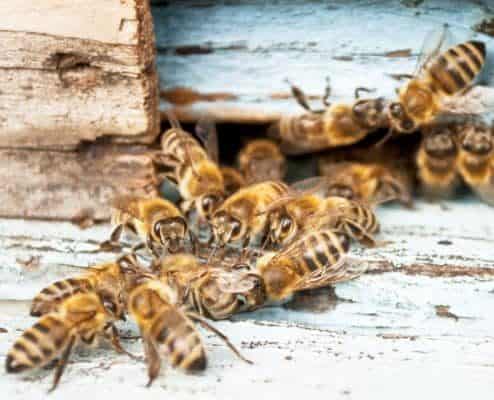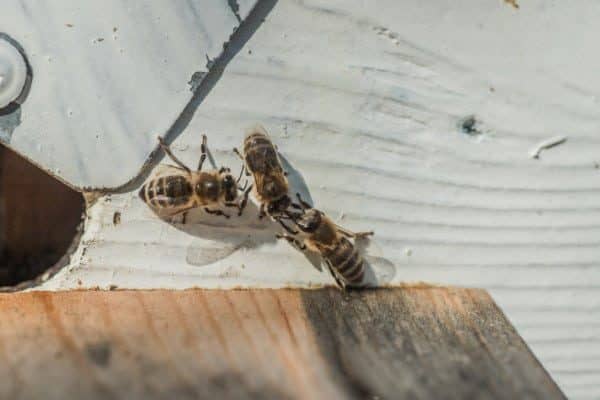
Bees are known for three things: producing honey, pollinating plants, and their painful stings. If you’ve ever been unfortunate enough to be stung by a bee, you already know it hurts. Small animals avoid bees like the plague out of fear of getting a nasty sting. But what about other bees?
Can a bee sting another bee? Yes, of course! Worker bees can sting robber bees from another hive that are trying to get entry to their hive to steal honey. Typically if a queen bee sees another queen in the hive, the two will fight to the death to determine who will stay alive. Male bees (Drones) don’t have a sting.
The act of bees stinging other bees is something that might be shocking to people. However, it’s quite a common occurrence. Here’s what you should know about what happens when bees sting other bees, and why they do it.
Can A Bee Sting Another Bee?
The short answer is that they can, and they do. When bees sting other bees, it’s a matter of protecting their hive. That being said, there are a couple of nuances to this classic bee question.
You see, certain types of bees are more likely to sting other bees. There are other factors that also dictate how often bees will be able to sting a target. Let’s take a closer look at what’s really going on here.
What Types Of Bees Sting Other Bees?
For the most part, bees don’t want to have fights, it’s not in their nature. Despite their sting-prone reputation, the truth is that bees just want to collect pollen and nectar to grow their colony. This in turn, pollinates many of the plants we rely on. However, they still have a need to protect their queen and their hive. That’s why there are two types of bees that are likely to sting other bees:
- Guard bees
- Queen bees
Guard Bees
In the hive, the vast majority of bees are worker bees. The worker bees perform many roles within the hive one of these roles is a guard bee. These bees are responsible for checking every bee entering the hive to ensure they are part of their colony.

Most communication between bees in the hive is through pheromones. Their communication technique is very interesting. We do have an article specifically about how bees communicate?
Each queen has her own distinctive pheromone that is carried by each bee in the hive. This allows the guard bee to quickly identify if an incoming bee belongs to their hive.
If the bee trying to enter does not belong to the hive the guard bee will release an alarm pheromone. This pheromone marks the bee as an intruder. It draws other worker bees to the threat. The bees will then ball around the intruder pushing her out the entrance often stinging her in the process.
Bees that mistakenly try to enter the wrong hive are an exception and are sometimes allowed in if they are loaded with nectar and pollen. These bees are not intending to rob the hive and pose no threat.
Queen Bees
Queen bees will not typically sting workers or drone bees. They will however sting other queens or queen cells. If a queen successfully emerges from a queen cell without being killed by the sting of the resident queen then something has to happen as beehives will only have multiple queens for a short time.
Typically one of three thing will happen:
- The old queen will take a significant number of worker bees and swarm. This means she will leave the hive with those workers and go in search of another location to build another hive.
- The worker bees decide the old queen has to go and will exterminate her usually by balling around her ultimately killing her.
- Queen on queen deathmatch. This is a no-holds-barred fight to the death with each queen trying to fatally sting the other. The winner takes all.
Can Male Bees Sting?
Believe it or not, male bees are not the “guard bees” that we discussed earlier. In fact, they really have only one role and that is to mate with a queen bee. They won’t however mate with the queen in their hive because that would be their mother.
The drone bees do have a sting, the stinger is so underdeveloped that their sting is not effective on other bees or humans.
So drones can’t sting bees that are trying to rob the hive.
Can Other Types Of Bees Sting Other Types Of Bees?
Though queens and guards are the most likely bee types to go after other bees with their stinger. In saying that, any type of worker bee can sting another bee. Every worker bee in the hive has a stinger, so it makes sense that they will be able to sting one another if necessary.
What Happens If A Bee Stings A Bee?
A bee sting might not be lethal to all people, but you better believe it’s lethal to other bees! A single bee sting will be enough to kill a regular bee, which is why most bee fights are fairly short-lived.
For queens, on the other hand, fight one on one and may take several stings before their queen opponent meets their fate and dies.
If the threat to the hive is larger like a yellowjacket wasp multiple bees will try and sting the wasp at one time. These wasps can be difficult to kill and there are often multiple bees who also lose their lives in the fight. Check out this video below from about the 5 minute mark. There is some good footage of honey bees attacking yellowjackets that are trying to enter their hive.
How Many Times Can A Bee Sting Another Bee?
Bees can continue to sting other animals as long as their stingers remain attached to their bodies. The problem is, with most mammals and birds, the stinger ends up getting stuck in the target’s body, which ends up killing the bee.
Most animals have skin that catches on the barbs of the worker bees’ stinger meaning she can’t retract the stinger from her victim. This is typically not the case with other insects.
Other bees are no exception; the barbs on the bees stinger don’t get stuck in another bee’s body. This means that bees can sting other bees multiple times with little risk of having their stinger getting caught and ripped from their abdomen.
Do All Bees Fight To Protect Their Hives?
If the threat level is critical, almost every bee will attempt to sting an animal (or bee) that is entering the hive with the intention to attack them. In fact, bees have an alarm pheromone that they release when the hive is under threat.
The alarm pheromone rapidly rallies other bees in defense of their hive. You don’t want to be the target once this alarm pheromone is released. Especially if you aren’t wearing protective clothing. You can very quickly find yourself being stung by multiple bees at one time.
Do Bees Attack Other Insects?
Though bees are naturally peaceful creatures, they will only attack other insects that try and enter their hive. The most commonly-attacked species include:
- Spiders. It should come as no surprise to anyone that spiders and bees don’t work well together.
- Hornets. There have been cases where hornets have attacked beehives. This resulted in bees protecting the hive via, you guessed it, stinging the hornets to death.
- Wasps. Wasps are a known rival of bees. If bees feel threatened by them, they will attack them without a second thought.
- Hive Beetles. Hive beetles are known for infesting beehives, rendering bees’ homes unlivable. Bees will try and sting the hive beetle however usually with little success. They do however try and push them to the extremities of the hive.
- Wax Moths. Another major rival of your average bee, wax moths, often find themselves targeted by bees due to the threat they pose to hives.
- Ants. Believe it or not, ants and bees don’t get along. A single sting is more than enough to get rid of an ant, which is why bees are known for attacking them on sight—rather than letting them get closer to the sugary hive.
The Wrap Up
While bees might not seem like the type of insect to want to sting members of its own kind, the truth is, these fuzzy little flyers do at times sting other bees when they are a threat to their own hive.
At the end of the day honey bees really just want to mind their own business and collect pollen and nectar. However, if they see another bee, insect, animal, or human as a danger to them, their hive or their queen then they will use their stingers as a weapon to kill or ward off the threat. Using their stinger is always a last resort.
